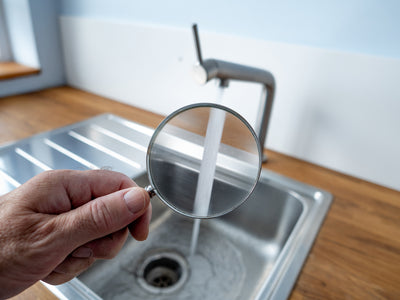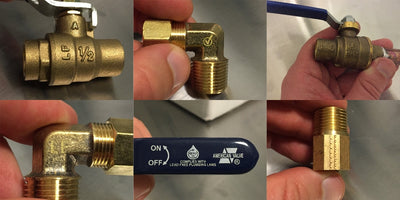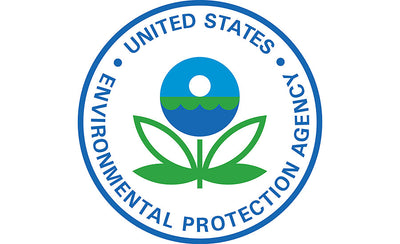Using a reusable water bottle and filling it up with filtered tap water can reduce your carbon footprint and save you money.
Water Quality InformationWritten By Actual Experts
RSSWhy Home Water Filters Are Better For The Environment:

How Did Hydroviv Perform in a Duke PFAS Removal Study?

Analies Dyjak, M.A. | Eric Roy, Ph.D.
Duke University and NC State researchers recently published a study that examined the effectiveness of residential water filters against PFAS. We believe that this study is extremely important because PFAS are toxic and unregulated, which means that individuals shoulder the burden to remove them from drinking water. While we were excited to be part of this study, Hydroviv is NOT endorsed in any way by Duke University, NC State, or any of the researchers, nor did we pay any money to be part of the study.
How Effective Were Hydroviv Water Filters in Removing PFAS?
Five Hydroviv filters were tested as part of this study, four of which use currently-available active media blends. For these core formulations, the researchers tested two Under Sink Filters that connect directly to the faucet and two Refrigerator Line filters that connect to the water line that feeds the refrigerator. In all four cases, any water with PFAS present in the unfiltered samples had undetectable (below the Method Detection Limit (<MDL)) levels of PFAS after the water was filtered through a Hydroviv filter (blue text in the table below). The results here are consistent with an earlier test report that looked at PFAS removal rates. We assembled the relevant data from the more recent study for our filters in the table below.

How Did Other Common Whole House, Pitcher, and Refrigerator Filters Perform?
Unfortunately, some of the most popular pitcher, refrigerator, and whole house filters did not perform well. Alarmingly, some systems by Berkey, Aquasana, Samsung, GE, and Brita, actually had HIGHER PFAS LEVELS in the filtered water than the unfiltered sample, because of over-saturation and low quality filtration media. The red text in the table below shows detectable PFAS levels in water filtered by other major brands.
How Did Reverse Osmosis Water Filters Perform?
This study evaluated a number of quality water filters that use reverse osmosis (RO) technology. In each of the RO systems that were tested, any water with PFAS present in the unfiltered sample also had undetectable levels in the filtrate.
If You’re Considering Purchasing a Water Filter That Was Not Part of this Study
The advice we give people looking for a water filter that removes PFAS is to ask the manufacturer for 3rd party test data for PFAS removal (not just PFOA/PFOS) at the beginning and end of the filter’s advertised lifetime. Unfortunately, there are a lot of water filter brands (including filters that performed horribly in this study) that show test data that were conducted when the filter cartridges were fresh, and do not show PFAS test data for the end of the advertised filter life (which they base off chlorine removal). Fortunately, Hydroviv’s Under Sink and Refrigerator Line Filters were tested at month 1 and month 6 as part of this study, as well as the filters that were tested as part of the NC State/CFPUA study several years ago.
Does Your Home Have Lead Plumbing? Here's How To Tell

Eric Roy, Ph.D. | Scientific Founder
We get a lot of questions about lead service lines and how to tell if you have lead pipes, and we thought that it would be worth putting together an article that talks about some of the lesser known places where lead can exist in residential plumbing. Most people are surprised to learn that up until 2014, EPA allowed lead exist in fixtures & valves used for drinking water lines!
The Evolution of “Lead Free” Plumbing
When the Safe Drinking Water Act (SDWA) was amended in 1986, it mandated that residential plumbing could not use any pipe, pipe fitting, solder, flux, or fixture that was not “lead free.” While the term “lead free” seems pretty straightforward, the law allowed for the definition of "lead free" to evolve. The chart below shows allowable lead levels in solder, pipes, fittings, and fixtures through the 25+ years that lead was phased out of plumbing. It's worth pointing out that, it wasn’t until very recently (2014) that all pipes/fittings/fixtures used for drinkable water were required to contain negligible amounts of lead.
Maximum Levels of Lead Allowed in Residential Plumbing
| Years | Solder/Flux | Pipes, Fittings, Valves |
| Before 1986 | 50% | 100% |
| 1986-2014 | 0.2% | 8% |
| After 2014 | 0.2% | 0.25% |
How to Determine If Plumbing in Your Home Is Lead Free
Solder: Unfortunately, there is no easy way to visually tell how much lead is in soldered joints after the connection is made. If you are getting plumbing work done, it's ok to ask your plumber to see the package for the solder that they are using. It should prominently say “lead free” on it.






What To Do If Your Home Has Lead Plumbing
As the US has become increasingly aware of lead contamination in drinking water because of the ongoing crisis in Flint, recent violations in large cities like Pittsburgh, and longstanding lead problems in old cities like Chicago and New York City, more and more people are asking what they can do to minimize their family's exposure to lead.
The best way, bar none is to:
- Use a high quality filter at each faucet used for drinking. Any filter should meet or exceed NSF Standard 53 for lead filtration performance.
If you are unable to use a rated filter, or if the filter you use does not protect against lead (like most pitchers and fridge filters), you can take the following steps to minimize exposure:
- Allow your faucet to run for at least 2 minutes before collecting water for consumption (drinking/cooking/washing food). Doing so allows the water sitting in the pipes to flush out and be replaced by fresh water flowing through the large mains.
- Only use the faucet at a slow flow rate when collecting water for consumption. Doing so minimizes the amount of lead particulates that can be swept into the stream and carried to the faucet.
As always, we encourage everyone to take advantage of Hydroviv's "Help No Matter What" technical support policy, where we answer questions related to drinking water and water filtration, even if you have no desire to purchase our products. Drop us a line about lead pipes in homes at support@hydroviv.com, or use our live chat function.
Related Articles:
Does New York City Tap Water Expose More People To Lead Than Flint?
Pittsburgh's Lead Level Exceeds EPA Limits In 2016
Why You Are Being Mislead By Your TDS Meter
Military Bases Have High Concentrations of PFAS Chemicals

***Updated 8/29/18 to include video***
Analies Dyjak | Policy Nerd
Per and Polyfluoroalkyl Substances (PFAS) have been receiving a ton of media attention throughout this past year. PFAS are a category of toxic contaminants that have invaded public and private drinking water systems across the entire country. Military bases are extremely susceptible to this type of contamination because of necessary on-base activities. If you would like to learn more about what PFAS are, their health effects, and if they're regulated, please click here.
Why Do Military Bases Have High Concentrations of Per and Polyfluoroalkyl Substances (PFAS)?
Military bases have historically had issues with pollution, due to the nature of on-base activities. Municipal fire departments also travel to nearby military bases because they provide an open, secure area to train. So not only are military personnel being directly exposed to PFAS chemicals in water, but so are local fire departments. The Department of Defence isn’t necessarily to blame for the high rates of contamination of PFAS on military bases. The Manufacturers of PFAS-containing fire fighting foam who actively sell to the DOD are greatly at fault. Because there is no effective alternative on the market, the military has no choice but to continue purchasing and using these products. Unlike many other countries, the United States doesn’t use the precautionary principle in chemical manufacturing. This means that chemicals are introduced to the market before toxicological due diligence is completed. Most of the time it takes someone getting extremely sick for manufacturers to even begin to pay attention.
More often than not, military bases have their own underground private wells that provide drinking water to families living on base, rather than being apart of a public drinking water system. Fire fighting foam can either directly percolate into soil, or run off into surrounding surface water sources. Water from contaminated soil naturally recharges on-base drinking water wells, which families consume on a daily basis.
What Is The Department of Defense Doing About Per and Polyfluoroalkyl Substances (PFAS) on Military Bases?
The most recent data provided by the DOD stated that 99% people receiving non-DOD-treated water were served by systems with no violations, whereas only 89% of people receiving DOD-treated water were served by systems with no violations. It’s important to note that these data are from bases that voluntarily tested for PFAS chemicals in water, but they do however reiterate that military bases have higher concentrations of this contaminant than other areas in the country. In October of 2017, the US Government Accountability Office reported that the Department of Defense has taken action on PFAS. DOD has directly shut down wells or provided filtration to 11 military installations. This is definitely a step in the right direction, but there are over 400 military bases in the United States that are still contaminated. Approximately 3 million people in the US drink water provided by the DOD. Not only are active military personnel at risk, husbands, wives and children are being adversely impacted by PFAS chemicals in water. Again, manufacturers of these dangerous chemicals are mostly to blame for such high concentrations of PFAS contamination on military bases.
What Are Public Officials Doing About Per and Polyfluoroalkyl Substances (PFAS)?
EPA set a Lifetime Health Advisory Level of 70 parts per trillion for both PFOA and PFOS. The rule of thumb for PFAS is that the sum of the category of contaminants should be no higher than 70 parts per trillion. ATSDR believes this level should be reduced to 20 parts per trillion for drinking water. Again, Lifetime Health Advisory Levels and Minimum Risk Levels are non-enforceable limits that municipalities are not required to follow. DOD has not developed their own standard for PFAS in drinking water and therefore follow the non-enforceable national level of 70 parts per trillion. DOD is not at all incentivized to create a standard or even test for PFAS, because of the outrageous mitigation expenses.
Other Articles We Think You Might Enjoy:PFAS: What You Need To Know
Recap of EPA's 2018 PFAS National Leadership Summit
PFAS: Toxicological Profile
Problems We Found With Chattanooga's Drinking Water
Analies Dyjak | Policy Nerd
For Hydroviv’s assessment of Chattanooga, Tennessee’s drinking water quality, we collected water quality test data from the city’s Consumer Confidence Report and the U.S. Environmental Protection Agency. We cross referenced Chattanooga’s water quality data with toxicity studies in scientific and medical literature. The water filters that we sell at Hydroviv are optimized to filter out contaminants that are found in Chattanooga’s drinking water.
Where Does Chattanooga Source Its Drinking Water?
Chattanooga sources its drinking water primarily from the Tennessee River. Water is treated at the Tennessee American Water Citico Water Treatment Plant before being distributed to the 177,000 residents of Chattanooga.
Disinfection Byproducts In Chattanooga’s Drinking Water
In recent years, Chattanooga has had a major problem with disinfection byproducts or DBPs. DBPs form when the chlorine-based disinfectants that are routinely added the water supply, react with organic matter. DBPs are split into two categories; Haloacetic Acids-5 (HAA5) and Total Trihalomethanes (TTHMs). Concentrations of TTHMs averaged 70 parts per billion, but were detected as high as 89.1 parts per billion in Chattanooga water. HAA5 concentrations averaged 41.8 parts per billion and reached levels as high as 51.4 parts per billion. For a bit of perspective, the EPA set a Maximum Contaminant Level of 60 parts per billion for HAA5 and 80 parts per billion for TTHMs. While Chattanooga's water quality is technically still in compliance, these levels are definitely high. Disinfection Byproducts are a category of emerging contaminants which means they have been detected in drinking water but the risk to human health is unknown. Regulatory agencies have very little knowledge about the adverse health effects of DBPs, and their toxicity.
Lead In Chattanooga’s Drinking Water
Lead enters tap water through old lead service pipes and lead-containing plumbing. 10% of sites that were tested for lead had concentrations over 2 parts per billion. Environmental Protection Agency, Center for Disease Control, and American Academy of Pediatrics all recognize that there is no safe level of lead for children. However, this years lead levels in Chattanooga are relatively low compared to other major municipalities in the US.
It’s important to note that only a handful of contaminants are required to be included in annual Consumer Confidence Reports, and that there are hundreds of potentially harmful unregulated contaminants that aren’t accounted for. If you’re interested in learning more about water filters that have been optimized for Chattanooga’s tap water quality, feel free to visit www.hydroviv.com to talk to a Water Nerd on our live chat feature or send us an email at hello@hydroviv.com.
Other Articles We Think You Might Enjoy:Lead Contamination In Drinking Water
Disinfection Byproducts In Drinking Water: What You Need To Know





